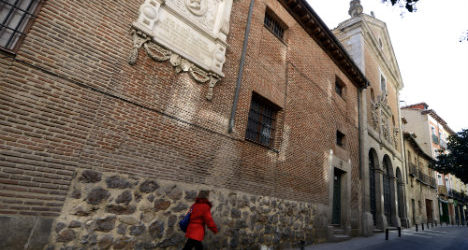Cervantes was buried in April 1616 in the church of the red-brick Convent of Trinitarians in central Madrid.
The exact site of his final resting place is a mystery, however, the location lost over the centuries during which the convent and church buildings were expanded.
The convent is still inhabited by nuns and has been designated part of Madrid's cultural heritage since 1921, complicating any effort to excavate in blind pursuit of Cervantes' remains.
Yet the Spanish capital feels it has a duty to find the remains of the author, who was born in 1547 in the university city of Alcala de Henares near Madrid but spent his final years in the capital.
"Finding the tomb of Cervantes would mean paying a very important debt to the Prince of Letters in Spain, to the Spaniard who has perhaps left the greatest mark in the history of humanity," said Jose Francisco Garcia, Madrid city hall's director of cultural heritage.
"For the city of Madrid it would be one of the most important cultural projects imaginable at the moment," he told news agency AFP.
The Madrid district where Cervantes lived is now named Letras, or Letters, in honour of him and other writers such as Lope de Vega and the great Golden Age rivals Francisco de Quevedo and Luis de Gongora.
"Quixote has had a universal significance and influence," said Garcia.
Published in two parts in 1605 and 1615 in its first editions, Cervantes' "The Ingenious Gentleman Don Quixote of La Mancha" is considered a satirical masterpiece, one of the key works of Western literature.
Despite the difficulties, Madrid's authorities believe a search for the author's remains is now feasible.
"The technology has advanced enough to enable us to interpret a ground-penetrating radar study and determine with sufficient confidence where human remains have been buried," Garcia said.
Madrid city hall has allocated a budget of €12,000-14,000 ($17,000-$19,000) for the first stage of a historical analysis, then the radar study, which would begin "within weeks".
"Before summer we should be able to draw conclusions from the study to know whether we can start archaeological excavations or not," Garcia said.
"We have permission from the owners, the congregation of nuns, as well as the Madrid region," he said.
The official urged caution, however, stressing that the project was still at an early stage awaiting the results of initial studies.
At least two other people were buried in the same area as Cervantes, said historian Fernando de Prado, who proposed the search for the author's remains to the Madrid city hall.
In his report, De Prado described the burial of Cervantes after his death, which historians date to April 22 or 23, 1616.
"Shrouded in sackcloth of the Third Order Regular of St. Francis of Penance, which he had joined shortly before, in a simple coffin, his hands on his chest holding a wooden crucifix and with his face uncovered… he was taken to his funeral on Saturday April 23 in what was probably the poorest convent of Madrid."
For the anthropologists, identifying the remains should be straightforward.
"We have been assured that if we find the remains we can reliably determine if they belong to Miguel de Cervantes by his specific physical characteristics," De Prado said.
Cervantes lost the use of his left hand to a gunshot wound received in the 1571 naval conflict, the Battle of Lepanto, in which the Holy League defeated the Ottoman fleet.
"Cervantes could not use that hand for 45 years. An anthropologist could identify that type of bone injury which could be used as evidence to identify him," De Prado said.



 Please whitelist us to continue reading.
Please whitelist us to continue reading.
Member comments